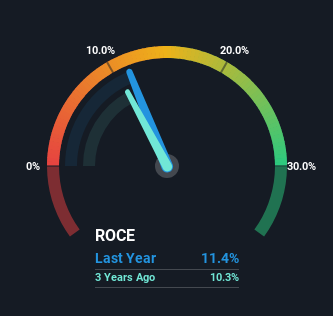- United States
- /
- Chemicals
- /
- NYSE:KOP
Investors Met With Slowing Returns on Capital At Koppers Holdings (NYSE:KOP)

What are the early trends we should look for to identify a stock that could multiply in value over the long term? Firstly, we'll want to see a proven return on capital employed (ROCE) that is increasing, and secondly, an expanding base of capital employed. Ultimately, this demonstrates that it's a business that is reinvesting profits at increasing rates of return. That's why when we briefly looked at Koppers Holdings' (NYSE:KOP) ROCE trend, we were pretty happy with what we saw.
What Is Return On Capital Employed (ROCE)?
For those that aren't sure what ROCE is, it measures the amount of pre-tax profits a company can generate from the capital employed in its business. To calculate this metric for Koppers Holdings, this is the formula:
Return on Capital Employed = Earnings Before Interest and Tax (EBIT) ÷ (Total Assets - Current Liabilities)
0.11 = US$190m ÷ (US$2.0b - US$287m) (Based on the trailing twelve months to September 2024).
Therefore, Koppers Holdings has an ROCE of 11%. In absolute terms, that's a satisfactory return, but compared to the Chemicals industry average of 8.1% it's much better.
Check out our latest analysis for Koppers Holdings

Above you can see how the current ROCE for Koppers Holdings compares to its prior returns on capital, but there's only so much you can tell from the past. If you're interested, you can view the analysts predictions in our free analyst report for Koppers Holdings .
So How Is Koppers Holdings' ROCE Trending?
While the current returns on capital are decent, they haven't changed much. Over the past five years, ROCE has remained relatively flat at around 11% and the business has deployed 30% more capital into its operations. Since 11% is a moderate ROCE though, it's good to see a business can continue to reinvest at these decent rates of return. Over long periods of time, returns like these might not be too exciting, but with consistency they can pay off in terms of share price returns.
The Bottom Line On Koppers Holdings' ROCE
The main thing to remember is that Koppers Holdings has proven its ability to continually reinvest at respectable rates of return. However, despite the favorable fundamentals, the stock has fallen 11% over the last five years, so there might be an opportunity here for astute investors. That's why we think it'd be worthwhile to look further into this stock given the fundamentals are appealing.
Since virtually every company faces some risks, it's worth knowing what they are, and we've spotted 2 warning signs for Koppers Holdings (of which 1 is concerning!) that you should know about.
While Koppers Holdings may not currently earn the highest returns, we've compiled a list of companies that currently earn more than 25% return on equity. Check out this free list here.
Valuation is complex, but we're here to simplify it.
Discover if Koppers Holdings might be undervalued or overvalued with our detailed analysis, featuring fair value estimates, potential risks, dividends, insider trades, and its financial condition.
Access Free AnalysisHave feedback on this article? Concerned about the content? Get in touch with us directly. Alternatively, email editorial-team (at) simplywallst.com.
This article by Simply Wall St is general in nature. We provide commentary based on historical data and analyst forecasts only using an unbiased methodology and our articles are not intended to be financial advice. It does not constitute a recommendation to buy or sell any stock, and does not take account of your objectives, or your financial situation. We aim to bring you long-term focused analysis driven by fundamental data. Note that our analysis may not factor in the latest price-sensitive company announcements or qualitative material. Simply Wall St has no position in any stocks mentioned.
About NYSE:KOP
Koppers Holdings
Provides treated wood products, wood preservation chemicals, and carbon compounds in the United States, Australasia, Europe, and internationally.
Fair value with limited growth.
Similar Companies
Market Insights
Community Narratives



